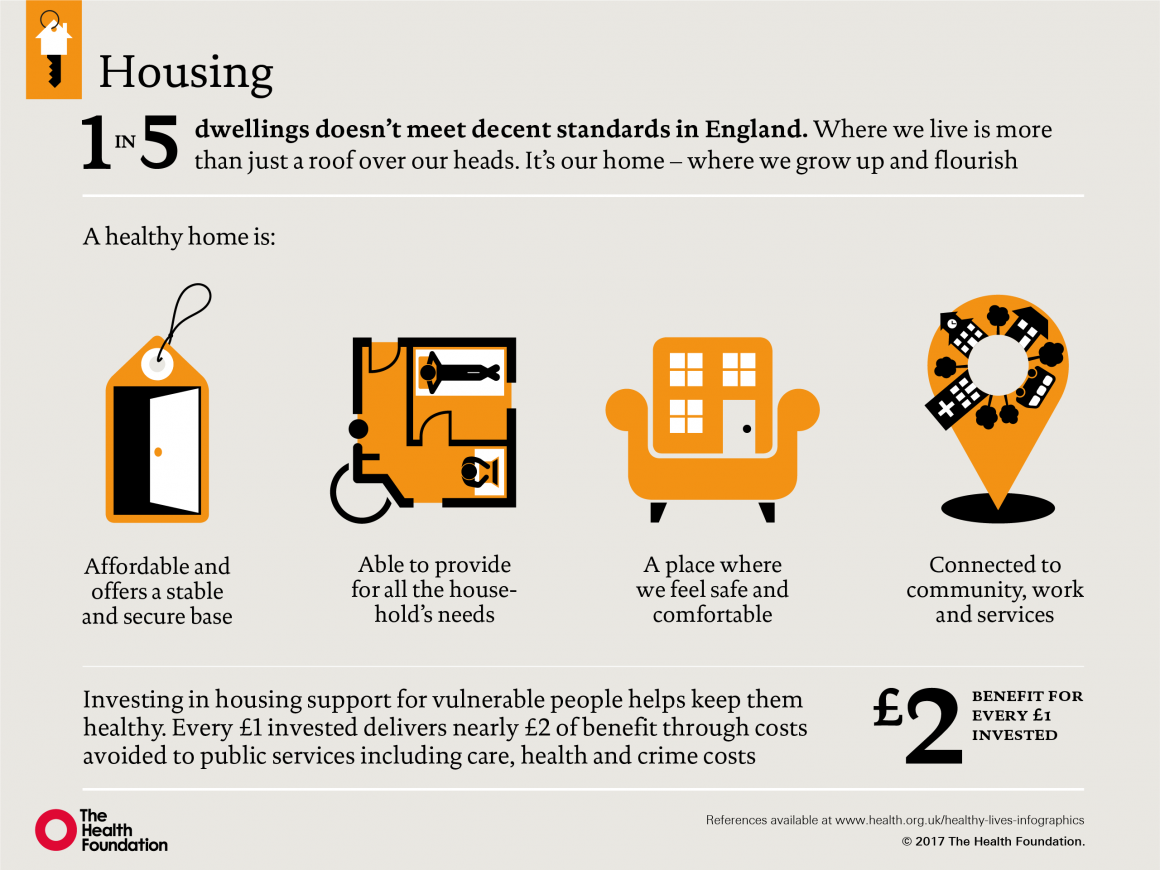How does housing influence our health?
31 October 2017

Get home, close the door, sink on to the sofa after a hard day. A familiar image? Adverts depicting smiling, happy people in lovely homes surround us. Having your own home is clearly an aspiration for our society.
Houses are more than physical structures providing shelter. They are homes – where we bring up our families, socialise with friends, our own space where we can unwind, keep our possessions safe and take refuge from the rest of the world. They’re where we spend most of our time.
Where we live can influence our health through many means. Our new infographic illustrates the main ways in which the links between housing and health play out.
We want our series of infographics to be a useful resource to help change the conversation about what makes us healthy. You are welcome to download, save and share them for education and non-commercial use. Please make sure that no modifications are made and that the Health Foundation and the source is clearly acknowledged in full.
If you have any further questions about using our resources in your work please get in touch at website@health.org.uk
It’s clear that housing conditions can influence our physical health. For example, a warm and dry house can improve general health outcomes and specifically reduce respiratory conditions. However, housing also has a huge influence on our mental health and wellbeing – children living in crowded homes are more likely be stressed, anxious and depressed, have poorer physical health, and attain less well at school.
While developing this infographic, I’ve also been house hunting. Looking down my list of requirements, it struck me that many of them were not about the house itself. Affordability was a huge factor, as was how easy it was to get to work, and travel to see friends and family. Living where you can afford and having security in knowing you won’t be kicked out at a moment’s notice helps us to put down roots and have a stable base. I realised I was also looking for a sense of community and belonging – somewhere I can feel linked to my neighbours and surroundings. I’m lucky that I have a degree of choice in where I live – but many don’t.
Housing has rarely been out of the news in recent months. As we highlight, 1 in 5 dwellings in England do not meet the Decent Homes standard, and a third of these are in the private rental sector, the fastest growing segment of the UK housing market. There is also unequal distribution of good quality housing. Those who are elderly or young, isolated, without a support network, and adults with disabilities are more likely to be affected. It’s not surprising that young people are concerned about this when they spend nearly a quarter of their income on housing – a theme that we are exploring in our Young people’s future health inquiry.
Throughout this series, we have been looking at the bigger picture of what makes us healthy. This infographic highlights the important contribution of housing. Where we live can promote our health if it is:
- affordable and provides a stable and secure base
- a place where we feel safe and comfortable
- able to provide for all the household’s requirements
- connected to community, work and services.
‘A safe, settled home is the cornerstone on which individuals and families build a better quality of life, access services they need and gain greater independence.’ This quote from Jake Eliot, formerly of the National Housing Federation, clearly illustrates how housing is key to improved health and wellbeing. Investing in housing, particularly for vulnerable people, can also affect and avoid costs for other public services, reducing costs of health services and residential care, for example.
We hope that this infographic further advances the recognition of the important links between housing and health. We also hope it helps support our colleagues working across housing, health, social care and other key areas such as planning to realise the vital contribution that they make in enabling good health and wellbeing. Working to ensure an adequate and affordable housing supply is not only a matter of social justice. As we illustrate, it also helps to support and improve people’s immediate and long term health prospects – and is fundamental to a society where people can flourish and realise their potential.
Joia de Sa is Public Health Specialty Registrar, working with the Health Foundation to develop our Healthy Lives infographics.
Related blogs
Work with us
We look for talented and passionate individuals as everyone at the Health Foundation has an important role to play.
View current vacanciesThe Q community
Q is an initiative connecting people with improvement expertise across the UK.
Find out more


